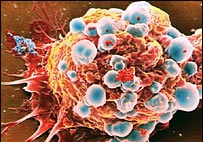
Kaposi’s sarcoma is typically seen in people with weakened immune systems, such as those with AIDS and organ transplant patients. It can also affect elderly men of Jewish or Mediterranean heritage. Patients with the disease develop patches of red or purple tissue under their skin.
The virus believed to cause Kaposi’s sarcoma has “mini-molecules” called microRNAs that silence genes that suppress tumor cells and limit vascular growth. The silencing of these genes results in the unchecked blood vessel growth typical of Kaposi’s sarcoma, said at team at the University of Florida.
The findings are published in the May 11 issue of Public Library of Science Pathogens.
“The hallmarks of Kaposi’s sarcoma are red spots full of blood vessels on the necks, arms and legs of patients. We think that the tumor virus is using microRNAs to make sure infected cells are well-nourished and protected from the human immune system,” Rolf Renne, an associate professor of molecular genetics and microbiology at the College of Medicine and a member of the UF Shands Cancer Center and the UF Genetics Institute, said in a prepared statement.
The findings may help in the development of new treatments for Kaposi’s sarcoma, the researchers said.
